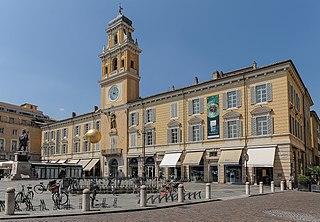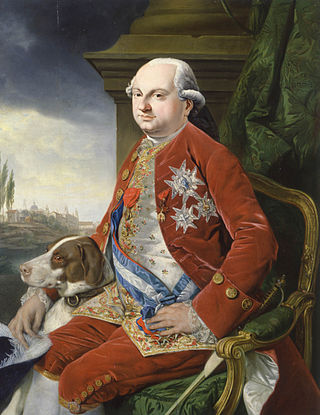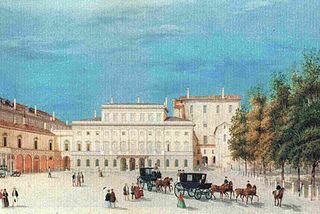

Ennemond Alexandre Petitot (1727-1801) was a French-born architect, mainly active in the Duchy of Parma.


Ennemond Alexandre Petitot (1727-1801) was a French-born architect, mainly active in the Duchy of Parma.
He was born in Lyon in 1727, and by 1741, he had joined the studio of the architect Jacques Soufflot. From there he moved to study at the Académie d'Architecture in Paris. From there he moved under a grant to study architecture in Rome, and was there recruited by the prime minister Guillaume du Tillot to become the architect of the recently installed Bourbon Dukes in Parma.
His projects envisioning updating the Duchy along the lines of the Neoclassical style regnant in France. Many of his ambitious projects have either been reduced, razed, or remained unfinished. He also published series of engravings on various designs for architectural decoration. Among his architectural projects in the Duchy of Parma
With the fall of minister du Tillot, and later the dislocations occurring Northern Italy after the French Revolution, the influence and scope of commissions for Petitot waned. He kept a teaching appointment at the Academy of Fine Arts of Parma. [2]

Parma is a city in the northern Italian region of Emilia-Romagna known for its architecture, music, art, prosciutto (ham), cheese and surrounding countryside. With a population of 198,292 inhabitants, Parma is the second most populous city in Emilia-Romagna after Bologna, the region's capital. The city is home to the University of Parma, one of the oldest universities in the world. Parma is divided into two parts by the stream of the same name. The district on the west side of the river is Oltretorrente. Parma's Etruscan name was adapted by Romans to describe the round shield called Parma.

The Duchy of Parma and Piacenza was an Italian state created in 1545 and located in northern Italy, in the current region of Emilia-Romagna.

The Duchy of Lucca was a small Italian state existing from 1815 to 1847. It was centered on the city of Lucca.

Ferdinand I was Duke of Parma, Piacenza and Guastalla from his father's death on 18 July 1765 until he ceded the duchy to France by the Treaty of Aranjuez on 20 March 1801. He was a member of the Spanish House of Bourbon.

Maria Amalia was duchess of Parma, Piacenza and Guastalla by marriage to Ferdinand I, Duke of Parma. She was born an archduchess of Austria as the daughter of Empress Maria Theresa and Emperor Francis I.

Colorno is a comune (municipality) in the Province of Parma in the Italian region Emilia-Romagna, located about 90 kilometres (56 mi) northwest of Bologna and about 15 kilometres (9 mi) north of Parma.

The Ducal Palace, also known as Reggia di Colorno, is an edifice in the territory of Colorno, Emilia Romagna, Italy. The palace we see today was refurbished by Francesco Farnese, Duke of Parma in the early 18th century on the remains of a former castle.

Antonio Farnese was the eighth and final Farnese Duke of Parma and Piacenza. He married, in 1727, Enrichetta d'Este of Modena with the intention of begetting an heir. The marriage, however, was childless, leading to the succession of Charles of Spain, whose mother, Elisabeth Farnese, was Antonio's niece, to the ducal throne.

Giuseppe Baldrighi was an Italian painter of the late Baroque (Rococo) and early Neoclassic periods.

Léon Guillaume (du) Tillot was a French politician infused with liberal ideals of the Enlightenment, who from 1759 was the minister of the Duchy of Parma under Philip, Duke of Parma and his wife Princess Louise-Élisabeth of France. At a time when both Bourbon France and Bourbon Spain thought of Parma as a strategic point of interest, Tillot favoured French policies abroad and wide-ranging reforms within the Duchy of Parma. He was made marchese di Felino.

The Biblioteca Palatina or Palatina Library was established in 1761 in the city of Parma by Philip Bourbon, Duke of Parma. It is one of the cultural institutions located in the Palazzo della Pilotta complex in the center of Parma. The Palatina Library was named after Apollus Palatinus.

Margaret Yolande of Savoy was Princess of Savoy from birth and later Duchess consort of Parma. A proposed bride for her first cousin Louis XIV of France, she later married Ranuccio Farnese, son of the late Odoardo Farnese and Margherita de' Medici. She died in childbirth in 1663.

Giuseppe Alinovi was an Italian painter, mainly painting vedute in a Neoclassical style, often in light watercolors. The Italian composer and court organist Giuseppe Alinovi was his father.
Gaetano Ghidetti was an Italian scenic designer, quadratura painter, and architect.
Pietro Antonio Martini was an Italian painter and engraver, active in a late Baroque style.

The Palazzo di Riserva, also known as the Palazzo delle Poste because for long it hosted the offices of the Postal Service, is a Neoclassical-style palace in central Parma, region of Emilia Romagna, Italy. The large structure now hosts the Museo Glauco Lombardi displaying collections from 19th-century Parma, as well as offices of the postal service, the provincial forestry service, a literary club, and several shops. It has been much altered over the years.

The Palazzo del Giardino or Palazzo Ducale del Giardino is a historic palace in the Parco Ducale in Parma. It is not to be confused with the official Parma residence of Marie Louise, Duchess of Parma between Palazzo della Pilotta and Palazzo della Provincia in what is now known as piazzale della Pace - she also lived at the Ducal Palace of Colorno and in the Casino dei Boschi in Sala Baganza. The main Ducal Palace in Parma, the Palazzo della Pilotta and the Reinach Theater were all destroyed in an early morning air raid on 13 May 1944, carried out by the 465th Heavy Bombardment Group of the US Airforce, 781st Squadron, which dropped 9 GP bombs on the city centre.

The Rocca Sanvitale or Sanvitale Castle of Sala Baganza is a fortress/palatial residence located on Piazza Gramsci #1, overlooking the small town of Sala Baganza, just southwest of Parma, region of Emilia-Romagna, Italy. It is distinct from the more-visited moated castle of Rocca Sanvitale, Fontanellato.

The Ducal Palace of Parma was a neoclassical palace in Parma, Italy. It was located on the west side of the located at the Piazzale della Pace. Between its construction and 1866, it was the residence of the Dukes of Parma. Afterwards, it became the prefecture. During the Second World War, the palace was destroyed during air raids in 1944, and it was afterwards not reconstructed.

The Palazzo del Governatore is a monumental building located in Piazza Garibaldi forming part of the civic center of Parma, region of Emilia Romagna, Italy. The building still houses municipal offices, as well as hosting cultural and social events. Across the Piazza Garibaldi are a number of other prominent buildings including the Palazzi del Podesta and del Comune, and the neoclassical Church of San Pietro Apostolo.